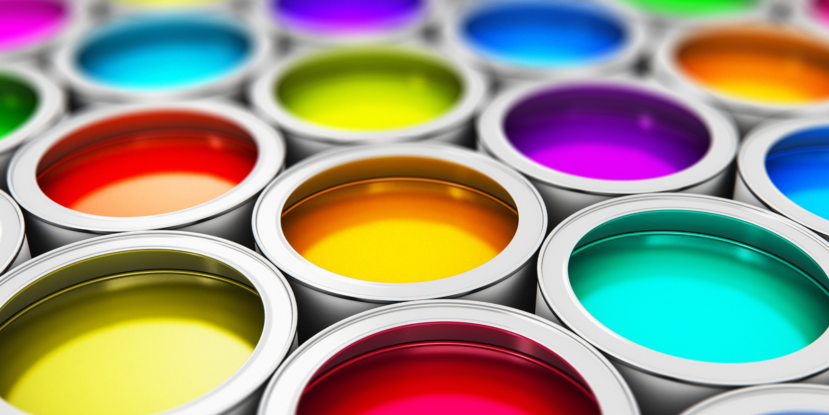Kolor jest potężnym narzędziem, które, jeśli odpowiednio wykorzystane, może znacząco przyczynić się do tworzenia bardziej przyjaznych i inkluzywnych interfejsów. Choć kolory są wszechobecne w naszym życiu, rzadko zastanawiamy się, jak dokładnie nasze oczy interpretują i przetwarzają światło, aby dać nam wrażenie różnorodnych barw. Dlaczego widzimy kolory tak, jak widzimy, i dlaczego jest to tak istotne? Odpowiedzi na te pytania ukazują nam nie tylko złożoność ludzkiego wzroku, ale również wpływ, jaki kolory mają na nasze codzienne doświadczenia i emocje.
Jak widzimy kolory?
Kolory towarzyszą nam od zawsze. Już jako dzieci wiemy, że w ciemności barwy znikają, a po deszczu pojawia się piękna, kolorowa tęcza. Do widzenia kolorów potrzebne jest światło, które jest falą.
Kiedy patrzymy na niebieską kartkę to tak naprawdę widzimy kolor, który jest efektem tego, jak światło odbija się od jej powierzchni. Źródło światła jest jak zbiorowa mieszanka wszystkich fal świetlnych, ale kartka selektywnie odbija tę jedną falę o długości odpowiadającej kolorowi niebieskiemu. Kiedy ta konkretna fala trafia do oka, czopki znajdujące się na siatkówce reagują na tę falę, generując impulsy elektryczne. Każdy rodzaj czopka jest wrażliwy na inne długości fal, co oznacza, że reagują one różnie na światło o różnych kolorach.
Te impulsy elektryczne są następnie przekazywane przez nerwy wzrokowe do różnych obszarów mózgu, takich jak kora wzrokowa, gdzie następuje ich przetwarzanie. Mózg analizuje wzorce tych impulsów, porównuje je z wcześniejszymi doświadczeniami i wzorcami kolorów, które zostały nabyte i rozwinięte przez całe życie.
Na podstawie tych wzorców i związków neuronowych, które są kształtowane przez doświadczenia związane z percepcją kolorów, mózg przypisuje odpowiednie kolory do otrzymywanych sygnałów elektrycznych. Innymi słowy, na podstawie informacji przekazywanych przez czopki oraz wcześniejszych doświadczeń i uczenia się, mózg decyduje, jakie kolory przypisać do widzianych obiektów i otoczenia. Proces ten ma charakter subiektywny i jest silnie związany z indywidualnymi doświadczeniami, życiowymi przyzwyczajeniami i preferencjami percepcyjnymi każdej osoby. Dlatego faktem jest, że każdy z nas widzi je inaczej. Zrozumienie tego procesu pozwoli z kolei lepiej zrozumieć percepcję barw oraz psychologiczne aspekty kolorów. Ale o tym później. Teraz zastanówmy się…
…jak monitory i smartfony wyświetlają kolory?
System RGB, czyli czerwony, zielony i niebieski, to podstawa tej technologii, która powstała w oparciu o właściwości odbiorcze ludzkiego oka. Ekran komputera czy smartfona jest urządzeniem, które samo z siebie emituje światło. Papier, tektura i nadruk, który na nich widzimy, nie świecą. To, czy je widzimy i w jakim kolorze je widzimy, zależy od światła odbitego. Praktycznie wszystkie dostępne na rynku kolorowe wyświetlacze, niezależnie od technologii, w której zostały wyprodukowane, działają na podobnej zasadzie. W zależności od obsługiwanej rozdzielczości składają się z od kilkuset tysięcy do kilku milionów pikseli odpowiedzialnych za wyświetlanie pojedynczego punktu na ekranie. Z kolei każdy piksel składa się z trzech subpikseli, z których każdy odpowiada za wyświetlanie jednego koloru z palety RGB – czerwonego, zielonego lub niebieskiego. Odpowiednie mieszanie trzech kolorów pochodzących z subpikseli pozwala na wygenerowanie barwy piksela. poprzez kontrolowanie intensywności światła w tych trzech kolorach, ekran może wyświetlić pełne spektrum kolorów, które widzisz na ekranie.
Jak różne barwy wpływają na emocje i zachowanie użytkowników?
Kolory mają przypisane psychologiczne i symboliczne znaczenia, dlatego też istotne jest, aby przed podjęciem decyzji o wyborze kolorów zrozumieć, jakie emocje i skojarzenia wywołują one u użytkowników.
Na przykład, ciepłe kolory, takie jak czerwień czy pomarańcz, pobudzają i dodają energii, ale w nadmiarze mogą powodować niepokój. Z kolei chłodne barwy, jak niebieski czy zielony, uspokajają i relaksują, choć długotrwałe ich obserwowanie może prowadzić do obniżenia energii i senności.
Istotne jest również uwzględnienie kontekstu kulturowego, biologicznych uwarunkowań oraz wrodzonych preferencji kolorystycznych. Na Zachodzie biały często symbolizuje czystość, podczas gdy w niektórych kulturach wschodnich jest kojarzony z żałobą. Teorie psychologii ewolucyjnej sugerują, że ludzie mają wrodzone preferencje kolorystyczne związane z przetrwaniem, np. kolor żółty może być atrakcyjny, ponieważ często oznacza dojrzałe owoce, będące źródłem pożywienia. Ciekawostką jest, że w XIX wieku zieleń była uważana za kolor trucizny, znaną jako zieleń Scheelego.
Chociaż nasze skojarzenia z kolorami są bardzo indywidualne, same barwy i ich odcienie mają pewne wspólne, powszechne właściwości, które wpływają na nas wszystkich w podobny sposób.
| Kolor | Cechy | Przykłady zastosowania w projektowaniu UI |
| Czerwony | Pasja, energia,niebezpieczeństwo, miłość | Powiadomienia o błędach, alerty, komunikaty, elementy akcentujące, itd. |
| Niebieski | Spokój, zaufanie, stabilność, integralność | Tła, przyciski nawigacyjne, formularze, ikony, paski postępu itd. |
| Zielony | Natura, wzrost, zdrowie, ekologia | CTA , tła sekcji, animacje relaksacyjne, kolor kroju pisma w treści, przyciski “zapisz” |
| Żółty | Optymizm, energia, ostrzeżenie | Przyciski “Dodaj do koszyka”, komunikaty sukcesu, zaznaczenie ważnych informacji, ikony ostrzegawcze |
| Pomarańczowy | Entuzjazm, kreatywność, ciepło | Elementy podkreślające ważność, przyciski “Dowiedz się więcej”, Banery promocyjne, powiadomienia o nowych ofertach |
| Fioletowy | Luksus, tajemnica, duchowość | Nagłówki wyróżniające, motywujące cytaty, przejścia między sekcjami z efektem płynności, okna modalne |
| Czarny | Elegancja, moc, powaga | Tła dla treści premium, elementy minimalizujące, kontrastujące akcenty, przyciski “Kup teraz” |
Wykorzystując psychologię kolorów, można nadać projektowi określony nastrój, jednak ważne jest, aby wybrane barwy przekazywały odpowiednie przesłanie na poziomie podświadomości i były zgodne z oczekiwaniami docelowego odbiorcy.
Jak osiągnąć spójność i harmonię kolorystyczną?
Kolory mają ogromne znaczenie w projektowaniu, dlatego już na początku projektu warto zdefiniować podstawowe cechy kolorystyczne, zgodne ze standardami percepcji barw. Określenie potencjalnych odbiorców i funkcji projektu to pierwszy krok do stworzenia harmonijnego systemu kolorów. Spójne i harmonijne interfejsy ułatwiają nawigację i zrozumienie prezentowanych informacji.
Oto kilka sposobów na osiągnięcie spójności kolorystycznej:
- Stosowanie palet kolorów: wybierz podstawową paletę kolorów i konsekwentnie stosuj ją w całym interfejsie. Narzędzia takie jak Adobe Color czy Coolors mogą być pomocne. Paleta powinna zawierać główne kolory dla różnych sekcji i interaktywnych elementów oraz kolory pomocnicze. Pamiętaj, aby nie przesadzić – optymalnie używaj 5±2 kolorów, zgodnie z zasadą ograniczenia pojemności poznawczej (ang. “cognitive load principle”). Testuj różne warianty kolorystyczne, aby znaleźć najlepszą paletę. Uważaj na intensywne kolory, które mogą być męczące dla oczu. Jeśli firma posiada swoją identyfikację wizualną, trzymaj się jej kolorystyki.
- Uwzględnienie kontrastu: zapewnij odpowiedni kontrast między tekstem a tłem, aby tekst był czytelny dla wszystkich użytkowników. Unikaj wzorzystych teł, które mogą utrudniać czytelność. Używaj kontrastu, aby wyróżnić interaktywne elementy, takie jak przyciski. Pamiętaj jednak, że zbyt skontrastowane barwy, np. żółć i czerń, mogą być męczące dla oczu, choć czasami są stosowane celowo.
- Konsekwencja w użyciu kolorów: przypisz określone kolory do określonych typów treści lub funkcji, np. jeden kolor dla odnośników, inny dla nagłówków. Unikaj nadmiernego mieszania różnych palet kolorów, co może dezorientować użytkowników. Optymalnie wybierz umiarkowaną liczbę kolorów, aby wyróżnić różne elementy interfejsu, zachowując harmonię i czytelność.
- Testowanie spójności: regularnie sprawdzaj spójność kolorystyczną na różnych urządzeniach i w różnych warunkach oświetleniowych, aby upewnić się, że kolory wyglądają zgodnie z zamierzeniem. Testuj różne warianty kolorystyczne na przykładowej stronie internetowej, aby ocenić, jakie wrażenia wywołuje dany przekaz.
Tematy poruszane w tym artykule są ważne nie tylko dla projektantów stron internetowych, ale dla wszystkich, którzy prowadzą firmy lub mają styczność z kolorami w swojej pracy. Zrozumienie zasad kolorystyki oraz umiejętność tworzenia spójnych i harmonijnych zestawień kolorów może znacząco wpłynąć na odbiór prezentowanych informacji przez użytkowników, co może mieć bezpośredni wpływ na skuteczność komunikacji oraz doświadczenie klientów.
Serwisy i aplikacje omawiane w artykule mogą być pomocne dla projektantów przy wyborze kolorów, ale nie zastąpią one konieczności przeprowadzenia rzeczywistych testów z udziałem użytkowników, które są właściwym wskaźnikiem użyteczności interfejsu.










 Młodszy specjalista ds. komunikacji marketingowej i PR.
Młodszy specjalista ds. komunikacji marketingowej i PR.


 Absolwent Uniwersytetu Warszawskiego oraz Szkoły Głównej Gospodarstwa Wiejskiego. W branży HoReCa od ponad 10 lat. Przez lata związany z Grupą Trip, Sobienie Królewskie Golf and Country Club oraz restauracją Florentin w Warszawe.
Absolwent Uniwersytetu Warszawskiego oraz Szkoły Głównej Gospodarstwa Wiejskiego. W branży HoReCa od ponad 10 lat. Przez lata związany z Grupą Trip, Sobienie Królewskie Golf and Country Club oraz restauracją Florentin w Warszawe. Absolwentka Wydziału Architektury Politechniki Warszawskiej na kierunku Architecture for Society of Knowledge oraz Komunikacji Wizualnej na Politecnico di Milano. Specjalistka od budowania nastroju. Doświadczenie zdobywała w kraju i zagranicą podczas licznych warsztatów międzynarodowych (Sevilla, Lizbona, Florencja), stypendium na La Sapienza (Rzym) oraz pracując m.in. w Carmi e Ubertis i ADM Milano.
Absolwentka Wydziału Architektury Politechniki Warszawskiej na kierunku Architecture for Society of Knowledge oraz Komunikacji Wizualnej na Politecnico di Milano. Specjalistka od budowania nastroju. Doświadczenie zdobywała w kraju i zagranicą podczas licznych warsztatów międzynarodowych (Sevilla, Lizbona, Florencja), stypendium na La Sapienza (Rzym) oraz pracując m.in. w Carmi e Ubertis i ADM Milano.








 Menedżer z wieloletnim doświadczeniem w branżach kosmetycznej, spożywczej, dziecięcej. W trakcie swojej kariery związany z firmami takimi jak: L’Oreal, Samsung, Danone-Nutricia, Unilever. W ciągu swojego życia zawodowego odpowiadał między innymi za rozwój sprzedaży i contentu eCommerce w Polsce i krajach Europy Środkowo-Wschodniej.
Menedżer z wieloletnim doświadczeniem w branżach kosmetycznej, spożywczej, dziecięcej. W trakcie swojej kariery związany z firmami takimi jak: L’Oreal, Samsung, Danone-Nutricia, Unilever. W ciągu swojego życia zawodowego odpowiadał między innymi za rozwój sprzedaży i contentu eCommerce w Polsce i krajach Europy Środkowo-Wschodniej. 

























































